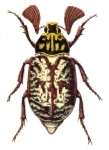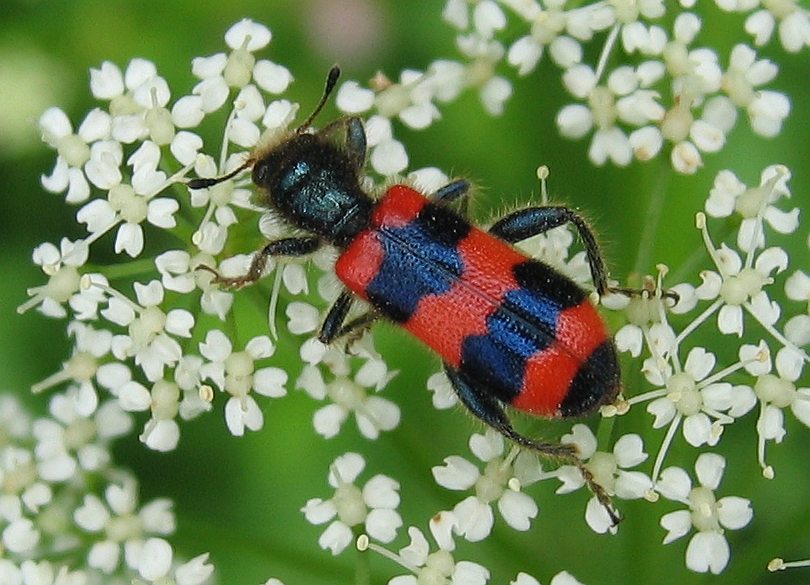|
Description / Habitats / Flora / Vertebrates / Insects / Invertebrates / What's that Bug? Home / Nestos Delta / Bibliography / About this site / Links / Contents / Galleries ____________________________________________________________________________ |
|
__________________________________________________________________________________________________________ THE CHECKERED BEETLES and ALLIES (COL., CLEROIDEA) OF THÁSOS Trichodes apiarius (c) Berger Harald The Superfamily Cleroidea in Europe contains ten Coleoptera Families, of which just four have been recorded from Thásos so far: the Cleridae (Checkered beetles), Dasytidae & Malachiidae (Soft-winged flower beetles) and the Trogositidae (Bark-gnawing beetles). Although taxonomically related, the individual Families vary considerably, such that the bark-gnawing beetles (like the narrow-bodied Nemozoma elongatum) bear little resemblance morphologically to the checkered beetles or soft-winged flower beetles (such as the familiar Malachius species). In most species the larvae develop in woody plants where they are predators on other insects, but the adults are usually encountered in nearby flowery grasslands or on trees where they feed on pollen and nectar and search for prey. In contrast, the Trogositidae spend most of their lives on or under bark feeding either on fungi or preying on bark beetle larvae. The Malachiidae are the most conspicuous as they can be abundant in suitable flower-rich habitats, but through May and early June the brightly-coloured Trichodes species (Cleridae) can also be frequent on flowers. Identification of the checkered beetles in Greece is possible thanks to the publication of a comprehensive review (Gerstmeir, R. 1998) but unfortunately identification of the Dasytidae and Malachiidae in the Eastern Mediterranean is far from straightforward and most genera are under taxonomic revision. To date, published keys exist for the dasytid genera of Aplocnemus (Liberti 2019), Danacea (Liberti 2009, 2017), Dasyticus (Majer 1988), Dasytidius (Majer 1989a), Enicopus (Liberti & Constantin 2009) and Schilskyana (Majer 1989b), whilst Constantin & Liberti (2011) is an excellent illustrated key to the French fauna that includes many of the species that can be found in Greece. There is, unfortunately, nothing comparable for the Malachiidae. Many species can be identified using Lompe's online keys but some genera are not fully covered. Similarly, there is no key to the Trogositidae of Greece, but the nine species known from the country are distinctive and Lompe's key will allow identification to species level [and Kolibáč's world review (2013) has excellent plates].
The taxonomic uncertainty surrounding much of the Greek Malachiidae and Dastyidae fauna means that it is impossible at this stage to gauge how many Cleroidea species might be present on Thásos. Liberti (1988) has published an account (which I have not seen) of the Dasytidae of the southern Aegean island of Santorini, but I am not aware of any other comparable literature on the Greek islands. I am grateful to Brian Levey, Piero Leo and Paul Whitehead for help with identification. CHECKLIST
Cleridae
Dasytidae
Dasytes subaeneus Schönherr, 1817
Micrinus sp. *
Unconfirmed records: Danacea pallipes (Panzer, 1793) recorded by Karnozickij in 1943 must be regarded as doubtful as Liberti (2009) is not aware of any reliable records from the Balkans. The single specimen from the Aplocnemus reitteri group is a female (length 6mm) with black femora, yellow tibiae, and brown tarsi. The antennae are all black except for articles 2-4 which are dark brown and the dorsal integument is deep black. Female specimens are not currently identifiable from existing keys, but size and colour seem to rule out two of the four Greek species in this group - leaving reitteri and the newly-described henrici (Liberti 2019) as possibilities.
REFERENCES
Constantin, R. & Liberti, G. 2011. Coleopteres Dasytidae de France. Societe linneenne de Lyon. Gerstmeir, R. 1998. Checkered beetles: illustrated key to the Cleridae and Thanerocleridae of the Western Palaearctic. Margraf Verlog, Weikersheim, Germany. Karnozickij, N. 1959. Materialien zur Koleopteren-Fauna der Agäischen Küste und Insel Thasos. Izv. zool. Inst. Sof., 8: 237-253. Kolibáč, J. 2013. Trogossitidae: A review of the beetle family, with a catalogue and keys. Zookeys, 366: 1–194. Liberti, G. 1988. The fauna of the Aegean island of Thira. VIII. Dasytidae (Coleoptera). Giornale Italiano di Entomologia, 4: 11–15. Liberti, G. 2009. The Danacea of the Balkan Peninsula. A revision (Coleoptera Dasytidae). Memorie della Societe Entomologica Italiana, 88: 17-116. Liberti, G. 2017. The Danacea of Turkey: a contribution to their knowledge (Coleoptera, Cleroidea, Dasytidae). Memorie Soc. Entomol. Ital., 94: 3-56.
Liberti, G. 2019. The
Aplocnemus Stephens, 1830, of Greece (Coleoptera, Cleroidea,
Dasytidae). A contribution to their knowledge. Atti Soc. it. Sci.
nat. Museo civ. Stor. nat. Milano, 6: 3-26 Majer, K. 1988. A revision of the genus Dasyticus Kiesenwetter, 1859 (Col. Melyridae, Dasytinae). Mitteilungen der Münchner Entomologischen Gesellschaft, 078: 127-154. Majer, K. 1989a. The genus Dasytidius Schilsky, 1896: species from Turkey and the Balkans (Coleoptera, Melyridae). Acta Entomologica Bohemoslovaca, 86: 137-155. Majer, K. 1989b. A Revision of the Genus Haplothrix Schisky, 1896 (Col. Melyridae). Mitteilungen der Münchner Entomologischen Gesellschaft, 079: 31-46.
|

















